State of Remote Work 2019
How employees across the United States think about working remotely, hybrid and remote team management, meetings, and more.
Remote work isn't the future of work — it's the present.
Millions of people report that they work remotely around the world and across the United States, and although many companies around the world have embraced the work from anywhere movement, many others don't know enough about how remote work would impact their employees, their teams, and their organizations to enable it.
Last year's Global State of Remote Work report shared findings on global remote work trends. This year, we focused our survey on the United States so we could learn more about who's working remotely, why they choose to work remotely, and what challenges they face in their jobs. We also wanted to learn how remote work impacts employee happiness, loyalty, and retention, what training remote workers receive, and how on-site workers feel about remote work.
Owl Labs produces this report every year because we're on a mission to make location irrelevant for remote workers and hybrid teams, and we want to share how remote work can improve outcomes for employees, organizations, and teams. Remote work can improve employee productivity, increase employee retention, and make employees feel more trusted and better able to balance work and life responsibilities — making for happier employees and more productive teams.
For this year's report, we partnered with workplace researcher, Kate Lister, president of Global Workplace Analytics, to ensure our approach was sound and our interpretations were grounded. Keep reading to learn more in the 2019 State of Remote Work report.

Published September 2019
I. Survey Demographics
Who Took the Survey
We surveyed 1,202 full-time workers in the United States between the ages of 22 and 65.

Who Works Remotely
Of the 1,202 people we surveyed, 745 (62%) work remotely at any frequency, and 457 (38%) work on-site. In this report, we'll refer to "remote workers" as people who work remotely at any frequency, and "on-site workers" as people who never work remotely.
How Often People Work Remotely
The 62% of survey respondents who work remotely do so at different frequencies. 54% of respondents work remotely at least once per month, 48% work remotely at least once per week, and 30% work remotely full-time.
Last year's Global State of Remote Work report found that 68% of workers around the world worked remotely at least once a month, indicating that the U.S. is slightly behind the global average in its adoption of remote work. However, last year's report also found that only 18% of workers around the world work remotely full-time, indicating that remote workers in the U.S. work remotely full-time 66% more frequently than the global average.
Among remote workers, respondents are most likely to work remotely full-time, with 49% of remote workers working remotely full-time, and remote workers are least likely to work remotely at least once per month, with only 10% of remote workers working at this frequency.
How Frequently All Respondents Work Remotely
The Schedules of Respondents Who Work Remotely at Any Frequency
Remote Work Frequency by Level
We broke down our survey respondents by job level to learn which levels work remotely most frequently.
Job Levels with Greatest Percentages of On-Site Workers
Job Levels with Greatest Percentages of Remote Workers

There are 18% more executives working remotely than there are working on-site.
Additionally, senior executives and above say they work remotely at least once per week 34% more than those in lower positions.
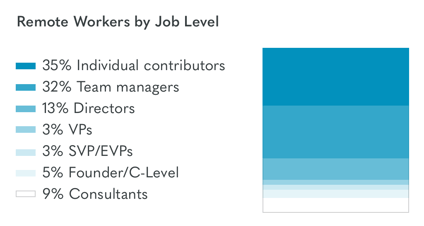
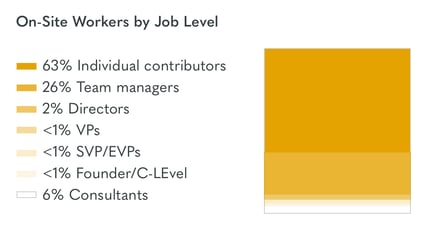
Which Industries Are Represented
Below, we've broken down the top industries represented by all respondents, by remote workers, and by on-site workers to see where the majority of respondents come from.
All respondents
OTHER CATEGORIES INCLUDED
Government (6%), Professional Services (6%), Technology/Internet (6%), Construction & Engineering (4%), Food & Beverage (3%), Hospitality (3%), Insurance (3%), Automotive (2%), Computing & Electronics (2%), Consumer Goods (2%), Entertainment (2%), Telecommunications (2%), Transportation (2%), Real Estate (1%), Agriculture (1%), Utilities (1%), Energy (<1%), Mass Media (<1%), Sports (<1%), Wellness & Fitness (<1%)
Remote workers
OTHER CATEGORIES INCLUDED
Healthcare (15%), Technology/Internet (10%), Financial services (9%), Education (8%), Manufacturing (7%), Professional Services (6%), Retail (6%), Construction & Engineering (5%), Government (5%), Computing & Electronics (4%), Insurance (3%), Automotive (2%), Consumer Goods (2%), Food & Beverage (2%), Hospitality (2%), Transportation (2%), Agriculture (1%), Entertainment (1%), Real Estate (1%), Telecommunications (1%), Energy (<1%), Mass Media (<1%), Sports (<1%), Utilities (<1%), Wellness & Fitness (<1%)
On-site workers
OTHER CATEGORIES INCLUDED
Healthcare (20%), Education (12%), Retail (11%), Government (7%), Manufacturing (7%), Financial Services (5%), Professional Services (5%), Construction & Engineering (4%), Food & Beverage (4%), Hospitality (3%), Insurance (3%), Automotive (2%), Consumer Goods (2%), Entertainment (2%), Transportation (2%), Technology/Internet (1%), Telecommunications (1%), Utilities (1%), Agriculture (<1%), Computing & Electronics (<1%), Energy (<1%), Mass Media (<1%), Real Estate (<1%), Sports (<1%), Wellness & Fitness (0%)
Which Departments are Represented
Among the respondents we surveyed, the departments that were most represented overall were Customer Support/Service/Success (17%), Facilities/Operations/IT (16%), Administrative (14%), Sales (12%), Other (8%), Product/Engineering (7%), Legal/Finance (7%), Human Resources (7%), Executive/Company Leadership (5%), Marketing (4%), and Education (3%).
Departments by Greatest Remote Representation
Departments by Greatest On-Site Representation
Salary Information
We broke down the data to learn if remote work correlated with higher or lower salaries, and we learned that remote workers earn salaries higher than $100,000 per year 2.2x more frequently than on-site workers. Seventy-four percent of the remote workers we surveyed earn less than $100,000 per year, as compared to the 92% of on-site workers surveyed who earn less than that amount. Twenty-six percent of the remote workers we surveyed earn more than $100,000 per year, versus the 8% of on-site workers who earn more than that amount.

Remote workers earn salaries higher than $100K/year 2.2x more frequently than on-site workers.
Salary Breakdown of Remote Workers
74% earn <$100,000 per year.
26% earn > $100,000 per year.
Salary Breakdown of On-Site Workers
92% earn <$100,000 per year.
8% earn over $100,000 per year.
These findings align with our Equal Pay for Equal Work (From Home) study from April 2019, which found that part-time or full-time remote workers are more likely to earn salaries over $100,000 than people who never work remotely.
Tenure Data
We asked about the tenure of survey participants at their respective organizations to learn if more or less tenured employees are trusted to work remotely.
36% more on-site workers have been at their current organization for more than 10 years, and that 7% more remote workers have been at their current organization for 5 years or fewer.
We also learned that 75% more on-site workers have worked in their positions for less than a year, indicating that newer employees work remotely less frequently. This may be a reflection of the fact that some employees may only be able to work remotely once they've been in their position and built team-wide trust over a period of time. It could also be an indication that people are looking for new job opportunities that allow them to work remotely sooner.
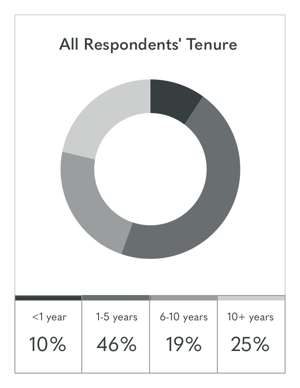
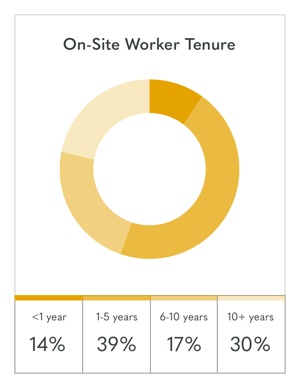
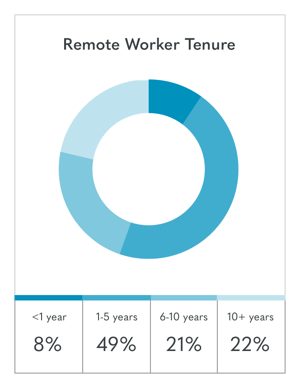
II. Happiness, Loyalty, and Retention
How Remote Work Impacts Employee Loyalty
We asked survey respondents to agree or disagree with a series of statements to learn how the ability to work remotely impacts their happiness at work and their loyalty to their company.
Among other findings, we learned that remote work or the ability to work remotely makes employees happier, feel more trusted, better able to achieve work-life balance, and more inclined to take a pay cut to benefit from added flexibility.

83% of survey respondents agree that the ability to work remotely would make them happier.
82% of respondents agree with the statement that working remotely would make them feel more trusted at work.
81% of respondents agree that working remotely would make them better able to manage work-life conflict.
81% of survey respondents agreed that the ability to work remotely would make them more likely to recommend their company to a friend.
80% of all survey respondents agreed that the ability to work remotely would make them less stressed.
80% of respondents agree that working remotely would make them feel like their employer cares.
74% of survey respondents agree that the ability to work remotely would make them less likely to leave their employer.
71% of survey respondents agree that the ability to work remotely would make them more likely to choose one employer over another in their next job.
34% of survey respondents would take a pay cut of up to 5% in order to work remotely.
24% of survey respondents would take a pay cut of up to 10% in order to work remotely.
20% of survey respondents would take a pay cut of more than 10% in order to work remotely.
Working Remotely in the Future
We asked respondents if they plan to work remotely more, less, or the same amount of time as they currently do in the future to learn how remote workers feel about their schedule — and if on-site workers want to work remotely at all. We learned that 42% of remote workers plan to work remotely more frequently in the next 5 years, and that more than half of on-site workers want to start working remotely. Only 19% say they do not want to work remotely.

We learned that 42% of remote workers plan to work remotely more frequently than they currently do in the next 5 years, and that more than half of on-site workers want to start working remotely.
Remote workers plan to work remotely more often in the future
On-site workers want to work remotely in the future.
How Remote Work Impacts Employee Happiness
We asked respondents if they feel happy in their job to compare employee happiness between remote and on-site workers. We found remote workers say they're happy in their jobs 29% more than on-site workers.

Full-time remote workers say they're happy in their job 22% more than people who never work remotely.
Remote workers are happier at work.
How Remote Work Impacts Employee Retention and Loyalty
We wanted to learn if employees who worked remotely were more loyal than on-site workers.
Remote workers say they are likely to stay in their current job for the next 5 years 13% more than onsite workers.
We also asked remote workers how it would impact their sense of loyalty if they were no longer allowed to work remotely in the future and learned that more than 6 out of 10 of remote workers would expect additional compensation to stop working remotely.
55% of remote workers would be likely to look for another job if they were no longer allowed to work remotely.
61% of remote workers would expect a pay increase if they were no longer allowed to work remotely.
Remote Work's Perceived Impact on Career Progression
Some employees express concern that a lack of office facetime or in-person mentorship could impact career development, but less than a quarter of remote workers shared their concerns.
68% of remote workers say they are not concerned working remotely will impact their career progression, while 23% say they fear it would.
III. Why Remote Work?
The Top Reasons for Working Remotely
We asked the remote workers we surveyed about the biggest reasons they decided to work remotely. They responded with: better work-life balance (91%), increased productivity/better focus (79%), less stress (78%) and avoiding a commute (78%). (This makes sense, because 30% of respondents who don't work remotely but want to in the future have a commute of 30 minutes or more each way.)
This year's results represent a shift toward greater interest in work-life balance compared to our 2018 Global State of Remote Work, where increased productivity/better focus and less stress topped the list.
-
91% better work-life balance
-
79% increased productivity/better focus
-
78% less stress
-
78% avoiding a commute
Which Benefits and Perks Are Most Important
We asked respondents about the perks and benefits that are most important to them when considering an employment opportunity and found there was little difference between preferences for remote and on-site workers.
For example, base compensation and health insurance were two of the top three priorities for both groups: 87% of on-site workers and 89% of remote workers prioritize base compensation, and 89% of on-site workers and 88% of remote workers prioritize health insurance. On-site workers care about health insurance 62% more than they care about stock options, and remote workers care about base compensation 43% more than they care about stock options.
Remote workers and on-site workers' priorities differ when it comes to schedule flexibility (92% more important to remote workers), workplace flexibility (42% more important to remote workers), and stock options (70% more important to remote workers).
Importance of Different Perks for All Respondents
Remote vs. On-Site Similarities
On-site workers care about health insurance 62% more than they care about stock options.
Remote workers care about base compensation 43% more than they care about stock options.
Remote vs. On-Site Differences
Importance of Different Perks for All Respondents
Schedule flexibility is nearly twice as important to remote workers (92%) as it is to on-site workers.
Workplace flexibility is 42% more important to remote workers than it is to on-site workers.
Stock options are 70% more important to remote workers than to on-site workers.
Transportation benefits are 73% more important to remote workers than to on-site workers.
Education/training reimbursement is 26% more important to remote workers than it is to on-site workers.
Parental leave is 23% more important to remote workers than it is to on-site workers.
Employee wellness programming is 17% more important to remote workers than it is to on-site workers.
Performance-based compensation is 8% more important to remote workers than it is to on-site workers.
Retirement matching is 3% more important to remote workers than it is to on-site workers.
Base compensation is 2% more important to remote workers than it is to on-site workers.
Vacation policy is 2% more important to on-site workers than it is to remote workers.
Health insurance is nearly equally important to remote workers and on-site workers.
IV. Productivity and Working Hours
How Many Hours Respondents Are Working
One stereotype about remote workers is that they work fewer hours than on-site workers, but many remote workers work as many or more hours than their on-site counterparts because it can be challenging to unplug from work. We asked respondents how many hours per week they work to compare remote workers and on-site workers.
Many remote and on-site workers feel overworked.

Remote workers say they work more than 40 hours per week 43% more than on-site workers do.
Why Respondents Are Working Longer Hours
For respondents who reported working more than 40 hours per week, we wanted to learn more about their reasons for working longer hours.
Remote workers and on-site workers are working 40+ hour work weeks for different reasons.
On-site workers are also working longer weeks because it's required, and more remote workers are doing so because they enjoy what they do.
Interestingly, 72% of both remote workers and on-site workers feel they're working the right amount of hours each week.
51% of respondents work > 40 hours per week to support their team.
39% of respondents work > 40 hours per week because it's required of them.
33% of respondents work > 40 hours per week because they enjoy what they do.
31% of respondents work > 40 hours per week to catch up on work.
23% of respondents work > 40 hours per week in order to meet unrealistic expectations.
V. Meetings
How Many Meetings Respondents Attend Each Week
Because meetings can be a challenging but critical opportunity for collaboration on remote and hybrid teams, we asked respondents questions about the number of meetings they attend each week so we could compare how remote and on-site workers are spending their time.

We learned that remote workers attend more meetings each week than on-site workers. 14% of remote workers are dedicating time to more than 10 meetings per week (vs. only 3% of on-site workers). On-site workers are spending 11% more time in 0-10 meetings per week, and remote workers are spending 11% more time in 11+ meetings per week.
Clear and open communication is critical for productive remote work, especially on hybrid teams, and it seems that remote workers are spending more time at work communicating with their colleagues, perhaps because they're working remotely.
How Many Meetings On-Site Workers Attend
How Many Meetings Remote Workers Attend
We also analyzed how meeting schedules differ across different salary bands and job levels to learn if senior leaders or higher-paid individuals need to spend more time in meetings than other groups.
How Many Meetings Employees at Different Levels and Salaries Attend
Challenges During Hybrid Meetings
During hybrid meetings (those with both on-site and remote meeting attendees from different locations), effective communication is the biggest challenge for both remote workers and on-site workers: Both groups cited interruptions and being talked over as their #1 challenge during these meetings.
The biggest challenges for on-site workers during hybrid meetings are interruptions/being talked over (61%) and staying focused during meetings (52%).
The biggest challenges for remote workers during hybrid meetings are interruptions/being talked over (67%) and IT issues during meetings (59%).
Meeting setup is 36% more challenging for remote workers.
Video quality is 26% more challenging for remote workers.
Internet speed and connectivity are 14% more challenging for remote workers.
Preparation in advance is 35% more challenging for remote workers.
IT issues during meetings are 18% more challenging for remote workers.
Staying focused during meetings is 11% more challenging for remote workers.
Audio quality is 26% more challenging for remote workers.
Interruptions or being talked over are 11% more challenging for remote workers.

Looking to make remote work better on your team? We'd be honored to help.
We're the creators of the Meeting Owl, an intelligent 360° video conferencing camera hybrid teams love. Its auto-focusing technology gives remote workers the feeling of sitting around the conference table with their team and helps everyone hold more productive meetings.
How Meetings Impact Productivity
We asked respondents how they would evaluate the productivity of their meetings to see if they’re more or less helpful for remote workers compared to on-site workers.
Remote workers say meetings reduce productivity 1.8X more than on-site workers.
How Meetings Reduce Productivity
VI. Remote Work Training and Management
How Many Remote Workers and Managers Received Training
We wanted to learn if any remote workers or remote employee managers received specific training on working remotely or managing employees who work remotely. We found that 38% of remote workers and 15% of remote managers received no training on how to work remotely.
30% of survey respondents currently or have previously managed remote workers. Of that group, 89% of respondents who've managed remote workers are or have been remote workers themselves, and the remaining 11% of remote employee managers work on-site.

Do remote workers receive training?
Do remote employee managers receive training?
The Biggest Challenges Facing Remote Employee Managers
We asked remote employee managers about their biggest challenges and concerns when it comes to managing their remote employees.
Remote employee managers are most concerned about reduced employee productivity (82%), reduced employee focus (82%), lower employee engagement and satisfaction (81%), and whether their remote employees are getting their work done (80%).
Remote employee managers are least concerned with employee loneliness (59%), the career implications of employees working remotely (65%), employees overworking (67%), and difficulty managing them (68%).
Despite the fact that research (including this report) shows that remote workers are choosing to work remotely to increase productivity and improve focus during working hours, many managers are still concerned about whether they're getting work done. What's more, these concerns are ignoring some of the other challenges remote workers are facing, such as feelings of loneliness and isolation.
To support these hybrid and remote working relationships, managers need training that's specific to remote workers to give them tools to evaluate performance and manage expectations when they don't physically work with direct reports.
We found that remote employee managers who've received training are concerned about these challenges to a lesser degree than the overall contingent of remote employee managers, suggesting that additional training helps assuage manager fears and concerns about employee productivity and work environment.
The biggest differences relate to employee productivity and focus: Remote employee managers who've received training are 15% less likely to be as concerned about these challenges as remote employee managers overall.
Concerns of remote managers without training
Concerns of remote managers with training
Do remote workers still shower when they get up for work every morning?

We asked respondents to share if they shower or bathe before work every morning to see if remote workers have the same morning routine as on-site workers heading into the office, and we found very little difference between the two groups, indicating that remote workers don't fit into the pajama-clad stereotype.
Thanks for reading the 2019 State of Remote Work report!
At Owl Labs, we believe employees should be able to work from anywhere with the right technology and team support in place. The State of Remote Work is a yearly benchmark report where we examine how companies and industries are adapting to the growth of remote work and hybrid teams to learn where we've made progress and where we have room for improvement to embrace and empower location-flexible work.
Download the 2019 State of Remote Work report in PDF format below, and share your thoughts on the report with Owl Labs on Twitter @OwlLabs using the hashtag #SORW2019.
Download the Data
Want to share this report with a colleague or reference on your own blog? Download the graphs in PDF format. All cited content should reference and link to the State of Remote Work.



